Researcher: Youngbin Kim
Start: July 2014
End: August 2014
Overview
Jellyfish, especially Moon jellyfish (Aurelia aurita), are overpopulating the Baltic and North Seas. Last summer we began investigating the culinary potential of this neglected but quite delicious species. This post outlines some existing cultural practices of using jellyfish as food in the world, and some of our attempts at giving it gastronomic context in the Nordic region.
Jellyfish is defined as ‘A free-swimming marine coelenterate with a jelly-like bell- or saucer-shaped body that is typically transparent and has stinging tentacles around the edge’(Oxford dictionary online). Jellyfish live in all the world’s oceans, from the surface to the depths (Wikipedia). Their size varies from a few millimeters to 2-3 metres in diameter. All jellyfish are carnivores, and different species feed on different foods such as zooplankton, fish eggs, fish larvae, small fish, and even other members of the same species – all of which, if excessive, can lead to the endangerment other species of marine animals (Darumas, 2013).
Jellyfish populations are blooming recently in many ocean environments where they haven’t been before. This phenomenon is resulting from the complex interactions of oxygen depletion, increase of plankton by eutrophication, extinction of jellyfish predators and feed competitors from over-fishing, temperature changes, water contamination, and other factors (Mills, 2001). Especially in the North and Baltic Seas, unusually high and increasing numbers of jellyfish have been reported. Some species are becoming invasive in the Baltic Sea, for example Aurelia aurita (moon jellyfish) and Mnemiopsis leidyi (comb jellyfish/sea walnut) and are causing diverse upsets in the existing ocean ecology (Kube et al. (2007), Møller & Riisgård (2007)).
In some Asian countries, particularly China, Japan, Korea and Thailand, jellyfish is eaten as a food for special occasions (Hsieh et al., 2001). Usually it is a cold dish, often a sort of salad with different vegetables, mustard sauce, soy sauce and sesame oil. In China especially, jellyfish has been regarded as an effective medicinal food for curing arthritis, bronchitis and lowering blood pressure (Hsieh & Rudloe, 1994). The traditional way to preserve the jellyfish is curing them with salt (NaCl) and alum (KAI(SO4)2) to lower their water content and pH, and giving a desirable crunchy texture (Hsieh et al., 2001). The edible jellyfish species of Asia are usually in the order Rhizostomae, however there are also other species which could be used as food shown in Table 1 (Omori & Nakano, 2001).

We know of no tradition of eating jellyfish in Denmark, nor in Europe in particular. If some new jellyfish species are becoming invasive and it results in different environmental and economic problems, then why don’t we eat them? Bringing jellyfish into our cuisine can be one way to help our local ecologies balance and to use natural resources in a more diverse way. But first, we have to figure out what species of jellyfish are in the Nordic seas, if they are edible, how they can be preserved, and how we can find their delicious side.
During my holiday last summer, I found a bloom of jellyfish in Roskilde fjord just west of Copenhagen. Literally, ‘BLOOM’. It covered the whole surface of the sea near the harbour so I couldn’t even see the bottom. These jellyfish were quite small, approximately 5-15 centimetres in diameter, with a transparent body and four distinct pinkish rings. Later, with help from Dr. Peter Gravlund who works in Danish National Aquarium, I figured out these jellyfish to be ‘Moon jellyfish’ (Aurelia aurita) which is increasing in many fjord areas around Denmark. This type does not sting people and is not toxic – so we could touch it, but were not certain if we could eat it.
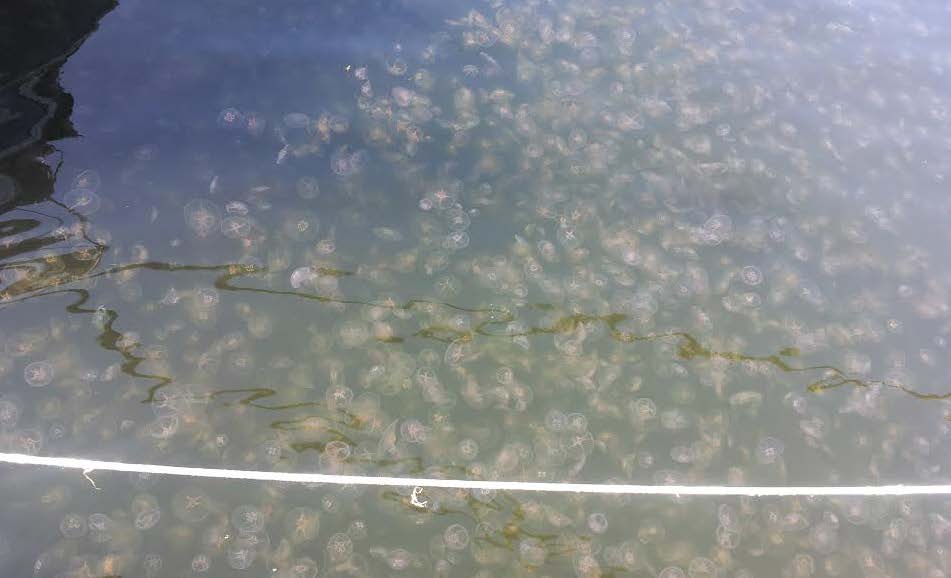
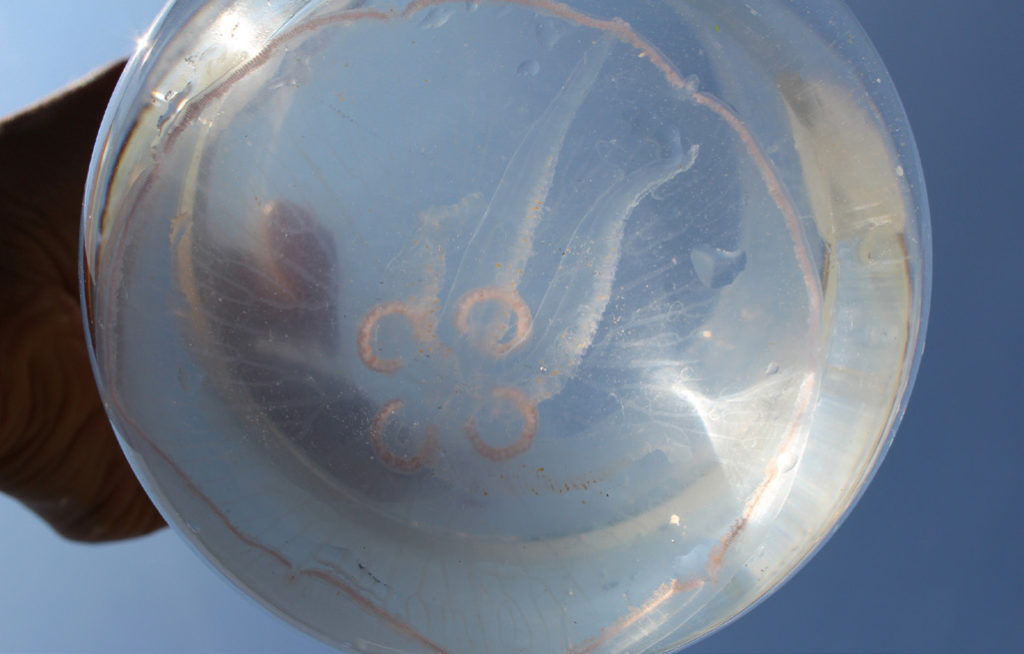
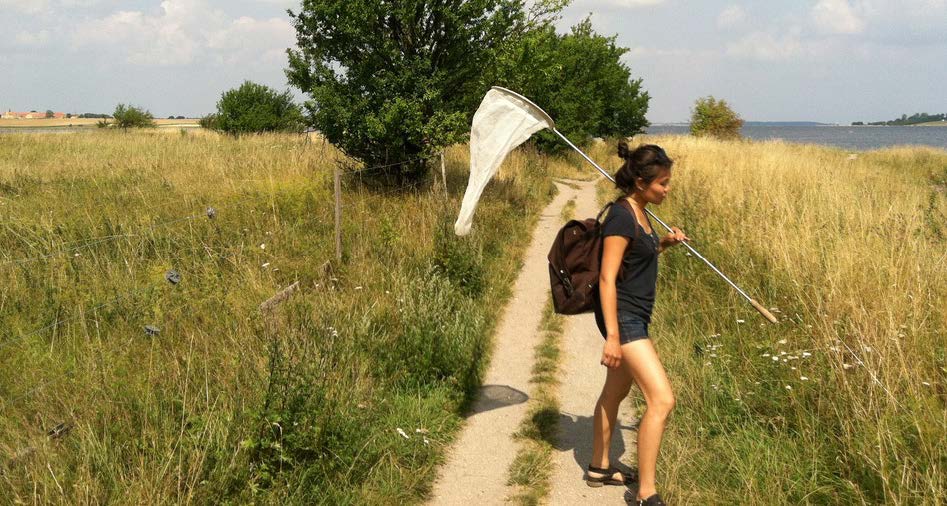
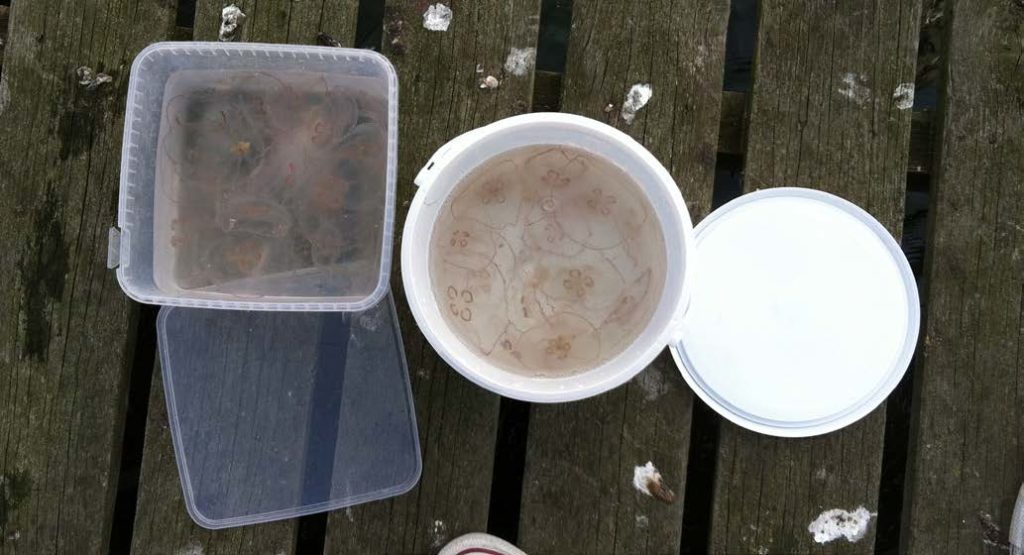
netting A. aurita in Roskilde
So, in the middle of last summer in Roskilde, we caught a bunch of Moon jellyfish. I divided them into two groups: in the first I separated the tentacles from umbrella part, and in the second I left them whole just to see how they might differ. To preserve them, I divided them in subgroups with different brines: NaCl in 3%, 10%, and 15%, the same three brines with 0.5-1% of calcium sulfate added (expecting different texture), and one in sea water as a control group.
Within 4 hours, the jellyfish had already started to dissolve in the brine and within 3 days they had all completely dissolved and disappeared. The water was extremely slippery like a huge bunch of mucus and smelled horrible like a rotten animal or seafood. The 3% brine and sea water ones in particular were terribly stinky even from their sealed boxes.
On the same day near our boat, we caught another jellyfish which was quite big and had a yellowish rigid body. Again, with the kind help of Dr. Gravlund, we figured out that this species was likely a ‘lion’s mane jelly fish’ (Cyanea capillata). I separated the tentacle and umbrella part and preserved them separately in 10% brine. After 3 days in the brine, the umbrella part looked fine, had shrunk a bit and smelled like fresh ocean. The tentacle part had almost dissolved in the water which turned the brine brown. Though the umbrella part seemed fine, we decided not to eat it because this species stings people which can cause rash or itchiness. I personally had a rash after catching it, and had some itchiness for a few days after.
Lion’s mane jellyfish just off our boat
The lion’s mane brought aboard
Lion’s mane mantle preserved in 10% brine
Lion’s mane tentacles dissolved in 10% brine
Lion’s mane mantle, close up
After this unsuccessful preserving experiment, however, we caught quite a large moon jellyfish with a nice rigid body just off the houseboat. We decided to experiment with the fresh jellyfish in the kitchen, not try to cure it because we wanted to keep the fresh oceanic flavour. Since another of my concurrent projects was on Kimchi, we used this Kimchi for making some dishes with the jellyfish. Through some preliminary trials of cooking the jellyfish, we realized that it was not possible to deep-fry or pan-fry the jellyfish due to its high water content. We also knew that moon jellyfish doesn’t sting the people and is not toxic. We ended up eating it raw and making four simple dishes with different applications of Nordic Kimchi.
Recipes with moon jellyfish
1. Jellyfish with Kimchi turnip and nasturtium stem
50g fresh jellyfish
1 turnip
Nordic Kimchi juice
2-3 nasturtium stems
Slice the turnip very thinly, full-seal in a vacuum bag with some Nordic Kimchi juice to impregnate flavour and make transparent. Wrap a slice of fresh jellyfish (~5cm) and a nasturtium stem with the thinly-sliced turnip.
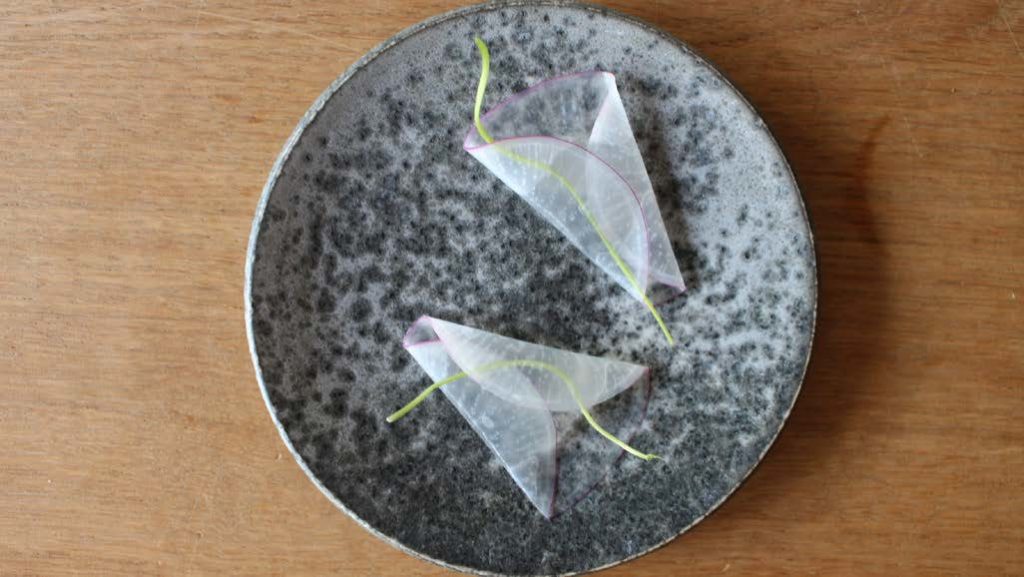
2. Jellyfish with romaine Kimchi and turnip Kimchi
50g fresh jellyfish
1-2 pieces of romaine Kimchi
20g turnip Kimchi
Finely cut turnip-sandleek-Kimchi in a small dice and full-vacuum in Kimchi water to give the transparency. Put one piece of romaine Kimchi and place the diced turnip. Put the sliced fresh jellyfish on top. Decorate with nasturtium leaves.
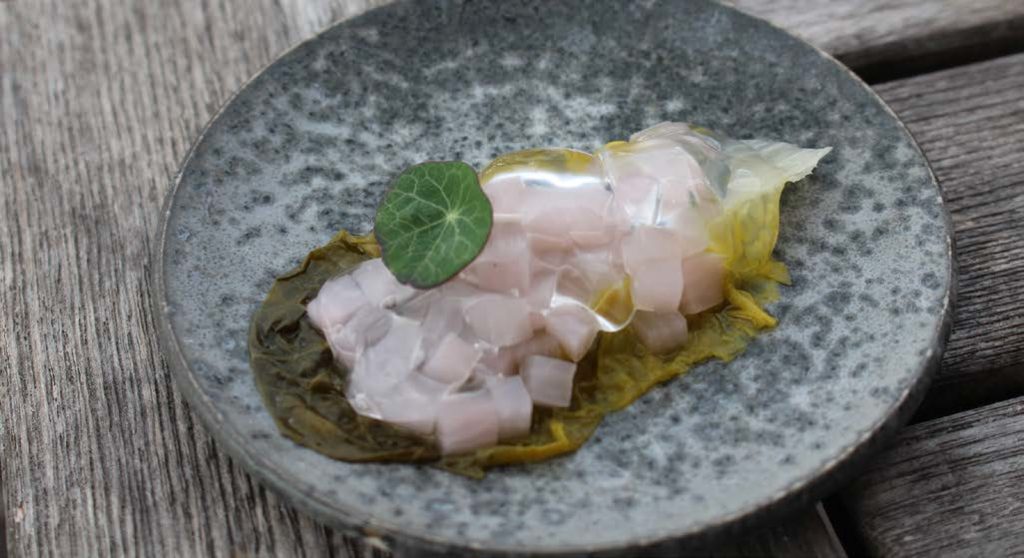
3. Jellyfish with mackerel garum
50g fresh jellyfish
5ml mackerel garum
Cut the fresh jellyfish into small chunks. Place in a spoon kept over ice, and pour over the mackerel garum. Keep cold.
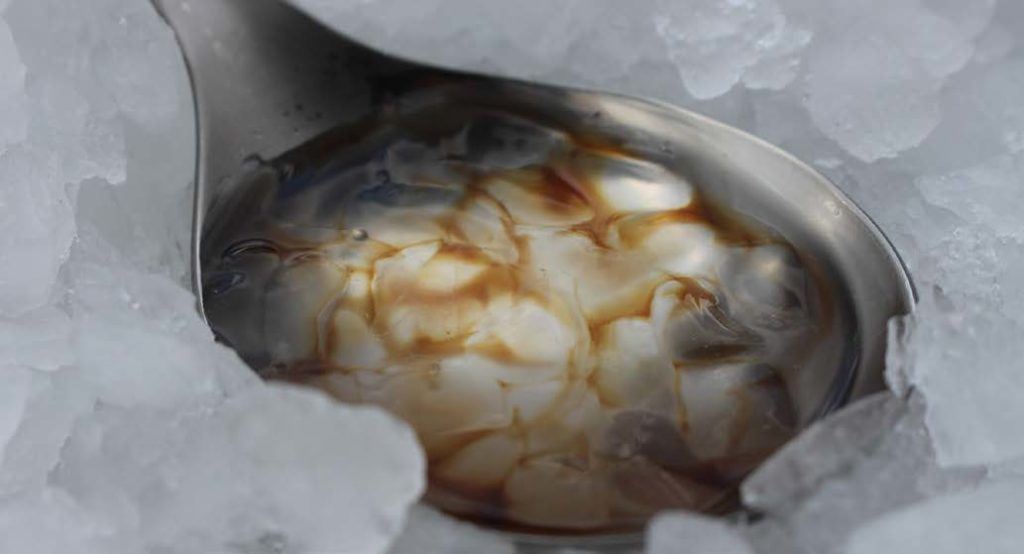
4. Jellyfish swimming in white Kimchi sea
50g fresh jellyfish
200g cold ‘Nordic’ Kimchi juice
1 small radish
1 turnip
Keep Nordic Kimchi water very cold. Make very thin slices of small radish and turnip, and full-vacuum them in a moon jellyfish shape with a small amount of Kimchi water to impregnate the flavour and make them more transparent. Slice a fresh jellyfish slightly larger than the turnip slice. Pour the Kimchi water into the bowl and let the jelly-radi-fish float in the Kimchi sea.
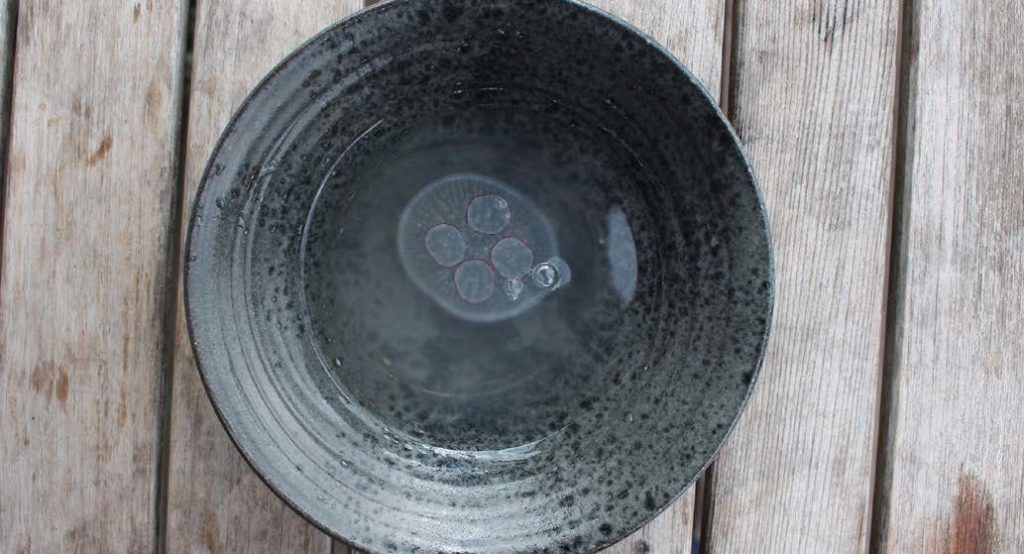
Further Ideas
Fresh jellyfish does not last long. So every time we need to catch the jellyfish to have it fresh. Fresh jellyfish tastes amazing – like eating the blue-green oceanic gel – but it will be very useful if we can develop a curing or preserving method for the jellyfish in the Nordic seas to keep them for longer periods. Traditional ways of preserving jellyfish in Asia do not seem applicable in the same way to moon jellyfish because they are quite small and their skin is too soft, which dissolves in the brine very quickly.
Though none of us died after eating the moon jellyfish on the boat, there is still a great need for more scientific knowledge on the edibility and safety of the edible jellyfish around Nordic region, for example research on possible parasites or any other doubts should be clarified.
Personally I have a strong interest in using edible jellyfish in cultures that have not yet eaten it. I do believe there is great potential in using jellyfish in cuisine as a new ingredient, which can bring us a unique crunchy, slippery texture and a fresh oceanic flavour.
And finally, a video of moon jellyfish swimming around.
References
Darumas, U (2013), Is the Presence of Jellyfish Problematic or Beneficial?, Walailak J Sci & Tech 2013; 10(3): 209-226
Hsieh, Y-H. P., Leong, F. M., Rudloe, J. (2001), Jellyfish as food, Hydrobiologia 451: 11–17
Hsieh, Y-H. P., Rudloe, J. (1994), Potential of utilizing jellyfish as food in Western countries, Trends in Food Science & Technology July 1994 IVol. 5
Kube, S., Postel, L., Honnef, C., Augustin, C. B. (2007), Mnemiopsis leidyi in the Baltic Sea – distribution and overwintering between autumn 2006 and spring 2007, Aquatic Invasions (2007) Volume 2, Issue 2: 137-145
Mills, C. E. (2001), Jellyfish blooms: are populations increasing globally in response to changing ocean conditions?, Hydrobiologia 451: 55–68
Møller, L. F. & Riisgård, H. U. (2007), Impact of jellyfish and mussels on algal blooms caused by seasonal oxygen depletion and nutrient release from the sediment in a Danish fjord, J. Exp. Mar. Biol. Ecol. 351 (2007) 92–105
Omori, M. & Nakano, N. (2001), Jellyfish fisheries in southeast Asia, Hydrobiologia 451: 19–26
Oxford dictionary online, http://www.oxforddictionaries.com/definition/english/jellyfish , accessed on 5th Aug 2014
Wikipedia online, http://en.wikipedia.org/wiki/Jellyfish , accessed on 5th Aug 2014
